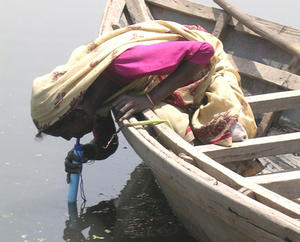WaterNew device could help stop one of the world's deadliest killers
A new portable and low cost water sanitation device could help save millions of lives each year; water borne diseases contracted from contaminated water are one of the world’s leading causes of death; each year nearly two million people die, primarily young children, from preventable diseases like diarrhea, cholera, and typhoid from drinking unsafe water; it is estimated that roughly 1.1 billion people lack access to clean water, but all that could potentially change thanks to Torben Frandsen’s LifeStraw; LifeStraw is a 10 inch long straw that is capable of generating 185 gallons of clean water, requires no electricity, and can be cheaply manufactured

Portable, effective and easily used - anywhere, anytime // Source: dwell.com
A new portable and low cost water sanitation device could help save millions of lives each year.
Water borne diseases contracted from contaminated water are one of the world’s leading causes of death. Each year nearly two million people die, primarily young children, from preventable diseases like diarrhea, cholera, and typhoid from drinking unsafe water.
Millions of people in third world countries are forced to drink contaminated water, as it can cost millions of dollars to install water purification plants and distribution mechanisms. It is estimated that roughly 1.1 billion people lack access to clean water, but all that could potentially change thanks to Torben Frandsen’s LifeStraw.
Frandsen has developed a portable, low-cost water purification tool that can generate 185 gallons of clean water, the amount of water an average person needs in a year, in the device’s life time.
Like the name implies, LifeStraw is a 10 inch long straw that is capable of killing micro-organisms that spread diarrhea, dysentery, typhoid, and cholera as well as bacteria like E. Coli and Salmonella.
The device is specifically designed for mass distribution in third world countries as it contains no moving parts and requires no electricity, which many areas lack. Instead it is powered by the simple act of sucking water through the straw.
LifeStraw can also be cheaply produced at an estimated cost of $2 dollars each.
The device relies on special PuroTech Disinfecting Resin which is a material that kills bacteria on contact. The straw alsocontains textile filters which remove particles smaller than fifteen microns as well as active carbon which withholds particles like parasites.
The device is even capable of filtering saline water, but continuous filtering of such water will reduce the effective life of the device to about ninety-two gallons.
LifeStraw has been nominated for an INDEX:Award, which is given to those who specifically design devices that significantly improve the lives of millions of people.
